Asia · Attractions · Featured · Food and Drink · Going Out · Japan · Regions · Travel Miscellany
Tokyo: tourism, temples and… toilets!
The toilet seat in my hotel bathroom lifts as I approach it. Its warm when I sit down, and it flushes itself once Ive finished. The lid even closes by itself afterwards should I forget. Yet, despite all this self-automation, I am not exaggerating when I say there are 15 different buttons to control the lavatory from which to select, depending on how the mood takes me. Yes, I have arrived in Tokyo.
 I was there as part of my trip with ANA (All Nippon Airways), having flown from the UK to Tokyo Haneda International Airport en route to Singapore. It was an opportunity not only to try out ANA’s business class seating but also to spend a few days in the Japanese capital. It was a chance to test the airline’s commitment to quality and service as demonstrated by its By Design campaign and to seek those same values in Japanese culture and traditions.
Returning to the toilets… its not just the lavatories that leave me a little perplexed. Wandering around Tokyo could leave you thinking you are in one huge operating theatre – many citizens wear face masks and yet Tokyo is one of the least polluted cities in the country, with very little industry. Apparently, these masks are worn more for the prevention of spreading or catching germs, and for some other reasons, rather than pollution concerns. The fascination with anime and manga by grown adults, not just children – is something that’s also completely alien to me.
I was there as part of my trip with ANA (All Nippon Airways), having flown from the UK to Tokyo Haneda International Airport en route to Singapore. It was an opportunity not only to try out ANA’s business class seating but also to spend a few days in the Japanese capital. It was a chance to test the airline’s commitment to quality and service as demonstrated by its By Design campaign and to seek those same values in Japanese culture and traditions.
Returning to the toilets… its not just the lavatories that leave me a little perplexed. Wandering around Tokyo could leave you thinking you are in one huge operating theatre – many citizens wear face masks and yet Tokyo is one of the least polluted cities in the country, with very little industry. Apparently, these masks are worn more for the prevention of spreading or catching germs, and for some other reasons, rather than pollution concerns. The fascination with anime and manga by grown adults, not just children – is something that’s also completely alien to me.
 With all this unfamiliarity, I was glad to have the services of two guides during my stay in the city. This proved to be invaluable and something Id recommend to any first-time visitor to Tokyo, even if its just to help you get around. There are more than 500 stations within Tokyos remarkable transport network and it was comparatively recently that these were marked in English. I cant imagine how difficult it must have been for a non-native to navigate before this.
To help me through this minefield, I first enlist the help of Context Travel – who go by the slogan ‘tours for the culturally curious’ – and am accompanied by Darren, an informative Australian who has been living in Japan for the past year. We first head for Asakusa, Tokyos old downtown. As we emerge from the metro system, Tokyos Skytree (left) stands tall alongside the Kirin beer company (centre), built to look like a glass of beer with froth on the top. Alongside it is a sculpture dubbed the ‘golden turd’ (right) – perhaps not one of Philippe Stark’s finest moments since it’s supposed to represent foam rising from a beer mug.
With all this unfamiliarity, I was glad to have the services of two guides during my stay in the city. This proved to be invaluable and something Id recommend to any first-time visitor to Tokyo, even if its just to help you get around. There are more than 500 stations within Tokyos remarkable transport network and it was comparatively recently that these were marked in English. I cant imagine how difficult it must have been for a non-native to navigate before this.
To help me through this minefield, I first enlist the help of Context Travel – who go by the slogan ‘tours for the culturally curious’ – and am accompanied by Darren, an informative Australian who has been living in Japan for the past year. We first head for Asakusa, Tokyos old downtown. As we emerge from the metro system, Tokyos Skytree (left) stands tall alongside the Kirin beer company (centre), built to look like a glass of beer with froth on the top. Alongside it is a sculpture dubbed the ‘golden turd’ (right) – perhaps not one of Philippe Stark’s finest moments since it’s supposed to represent foam rising from a beer mug.
 We venture towards Sensō-ji, an ancient Buddhist temple with an adjacent Shinto shrine. The site has a history dating back to the 7th Century but the temple was bombed during World War II and has since been re-built.
We venture towards Sensō-ji, an ancient Buddhist temple with an adjacent Shinto shrine. The site has a history dating back to the 7th Century but the temple was bombed during World War II and has since been re-built.
 As we reach the temple, we stop at an omikuji stall and Darren shakes a metal container in my direction, telling me to select a fotune stick. It has the number 92 on it and we find the corresponding drawer to find my fortune.
As we reach the temple, we stop at an omikuji stall and Darren shakes a metal container in my direction, telling me to select a fotune stick. It has the number 92 on it and we find the corresponding drawer to find my fortune.
 I’m in luck… it’s a good fortune! What’s more, this is one of the few shrines where the fortune is also written in English. The translation on the reverse reads:
No. 92 GOOD FORTUNE. Always traveling around since your childhod has given you a lot of places. It is a good sign to dream of a young horse in spring and a dream of a swift horse will bee a much better sign. Wherever you go, everything can be done as you wish. When an arrow goes straight, you will get a catch. Good luck will come to you from the heaven. *Your wish will come true. *The sick person will get well. *The lost article will be found. *The person you are waiting for will come soon. *Building a new house and removal are both good. *It is good to make a travel. *Marriage and employment are both good.
Darren is less fortunate and selects a bad fortune so ties it to something, as is the tradition, in order to leave the bad luck behind. This is a popular attraction in Tokyo, particularly at the time of Sanja Matsuri, a Shinto festival to honour the three founders of Sensō-ji when an estimated two million people visit in a period of just three days.
I’m in luck… it’s a good fortune! What’s more, this is one of the few shrines where the fortune is also written in English. The translation on the reverse reads:
No. 92 GOOD FORTUNE. Always traveling around since your childhod has given you a lot of places. It is a good sign to dream of a young horse in spring and a dream of a swift horse will bee a much better sign. Wherever you go, everything can be done as you wish. When an arrow goes straight, you will get a catch. Good luck will come to you from the heaven. *Your wish will come true. *The sick person will get well. *The lost article will be found. *The person you are waiting for will come soon. *Building a new house and removal are both good. *It is good to make a travel. *Marriage and employment are both good.
Darren is less fortunate and selects a bad fortune so ties it to something, as is the tradition, in order to leave the bad luck behind. This is a popular attraction in Tokyo, particularly at the time of Sanja Matsuri, a Shinto festival to honour the three founders of Sensō-ji when an estimated two million people visit in a period of just three days.
 Our next stop is a ramen shop. The ordering system intrigues me. There are models of the dishes outside, and a machine where you select what youd like and it spews out a ticket.
Our next stop is a ramen shop. The ordering system intrigues me. There are models of the dishes outside, and a machine where you select what youd like and it spews out a ticket.

 I learn from Darren that, when it comes to food, the Japanese talk about five basic tastes not just sweet, sour, bitter and salty – but also umami which apparently translates to mean ‘delicious and savoury’ yet is distinct from salty and said to be found in foods with a high level of glutamate. The term is a new one to me and, as we try the gyoza, I’m not sure if I can put my finger – or rather, my tastebuds – on it, but they’re good nevertheless.
I learn from Darren that, when it comes to food, the Japanese talk about five basic tastes not just sweet, sour, bitter and salty – but also umami which apparently translates to mean ‘delicious and savoury’ yet is distinct from salty and said to be found in foods with a high level of glutamate. The term is a new one to me and, as we try the gyoza, I’m not sure if I can put my finger – or rather, my tastebuds – on it, but they’re good nevertheless.
 Following our snack, we move on to Ueno Park where they celebrate Hanami – an amazing cherry blossom spectacle for just two weeks in April. There are over one thousands trees along the street leading towards the National Museum and around Shinobazu Pond. They are decidedly bare at the time of our visit, but this will soon change and the area will be packed with Hanami picnic parties. Visitors will claim their ‘spot’ on a ‘first come, first served’ basis by laying down a picnic sheet, but without claiming an area that is larger than they need. One thing I learnt on my visit is that the Japanese are a polite and respectful nation.
Following our snack, we move on to Ueno Park where they celebrate Hanami – an amazing cherry blossom spectacle for just two weeks in April. There are over one thousands trees along the street leading towards the National Museum and around Shinobazu Pond. They are decidedly bare at the time of our visit, but this will soon change and the area will be packed with Hanami picnic parties. Visitors will claim their ‘spot’ on a ‘first come, first served’ basis by laying down a picnic sheet, but without claiming an area that is larger than they need. One thing I learnt on my visit is that the Japanese are a polite and respectful nation.
 After passing through a bustling market that lies beneath some train tracks, we move on to Akihabara, known as the Electric City because it’s a part of Tokyo where you’ll find everything (and anything!) electrical.
After passing through a bustling market that lies beneath some train tracks, we move on to Akihabara, known as the Electric City because it’s a part of Tokyo where you’ll find everything (and anything!) electrical.
 Whether you’re after solenoids or speakers, you’ll find it all here.
Whether you’re after solenoids or speakers, you’ll find it all here.
 Darren points out some bizarre-looking contraptions for strengthening facial muscles and, I think, for keeping your skin young and supple. Theres not just one or two on the market theres scores of them and theyre not cheap either.
Darren points out some bizarre-looking contraptions for strengthening facial muscles and, I think, for keeping your skin young and supple. Theres not just one or two on the market theres scores of them and theyre not cheap either.
 Here we also find ourselves in the manga and anime district, where women dressed in maid costumes beckon passers-by to dine in maid cafés. Apparently, it’s all very innocent. If I was able to relate to manga or anime in any way, perhaps it would all make more sense to me but instead I’m left feeling rather culturally ignorant, but happy to be that way!
Here we also find ourselves in the manga and anime district, where women dressed in maid costumes beckon passers-by to dine in maid cafés. Apparently, it’s all very innocent. If I was able to relate to manga or anime in any way, perhaps it would all make more sense to me but instead I’m left feeling rather culturally ignorant, but happy to be that way!
 The following day, I value the company of another guide Yuki, organised through Inside Japan – and see another side to the city, starting at Tsukiji fish market.
The following day, I value the company of another guide Yuki, organised through Inside Japan – and see another side to the city, starting at Tsukiji fish market.
 You need to have your wits about you when you first arrive as there are little vehicles whizzing about from one place to another. Tsukiji itself I find fascinating – it is the largest fish market in the world. I could watch for hours as traders scurry up and down, fish are gutted, knives are sharpened and a huge block of frozen tuna is cut into steaks with the aid of a bandsaw.
You need to have your wits about you when you first arrive as there are little vehicles whizzing about from one place to another. Tsukiji itself I find fascinating – it is the largest fish market in the world. I could watch for hours as traders scurry up and down, fish are gutted, knives are sharpened and a huge block of frozen tuna is cut into steaks with the aid of a bandsaw.

 I feel honoured to experience the market since it is due be re-located to Tokyo’s Toyosu district next year and ask my guide if I can browse a little longer, and she duly obliges. This place should be high on your ‘to do’ list if visiting Tokyo and you have until November 2016 before it moves ahead of the 2020 Olympics.
I feel honoured to experience the market since it is due be re-located to Tokyo’s Toyosu district next year and ask my guide if I can browse a little longer, and she duly obliges. This place should be high on your ‘to do’ list if visiting Tokyo and you have until November 2016 before it moves ahead of the 2020 Olympics.

 Five million pounds of seafood worth in the region of $30 million is handled here every day, involving an estimated 60,000-strong workforce.
Five million pounds of seafood worth in the region of $30 million is handled here every day, involving an estimated 60,000-strong workforce.

 There are seven main wholesalers licensed by the government at the fish market, 800 intermediate wholesalers and some 300 or so retailers just outside the market but with some association with the industry vendors of dried fish, bonite flakes, kelp, pickles, tsukudani, knives and more, as well as a number of eateries.
There are seven main wholesalers licensed by the government at the fish market, 800 intermediate wholesalers and some 300 or so retailers just outside the market but with some association with the industry vendors of dried fish, bonite flakes, kelp, pickles, tsukudani, knives and more, as well as a number of eateries.


 With our browsing complete, we take shelter from the rain at the Sushi Zanmai sushi restaurant. Staff here have name badges that show which of the 47 prefectures of Japan they are from, and what their hobby is. Our sushi chef, who apparently likes sport, prepares me the traditional sushi platter, an assortment of sushi which includes raw tuna, cooked conger eel, salmon roe, squid and kelp with herring roe.
With our browsing complete, we take shelter from the rain at the Sushi Zanmai sushi restaurant. Staff here have name badges that show which of the 47 prefectures of Japan they are from, and what their hobby is. Our sushi chef, who apparently likes sport, prepares me the traditional sushi platter, an assortment of sushi which includes raw tuna, cooked conger eel, salmon roe, squid and kelp with herring roe.
 With our fill of sushi, we move on to Hama-rikyu Gardens, the family garden of the Tokugawa Shogun which served as an outer fort for Edo Castle and that retains a tidal pond of seawater. Black pine trees appear to do well here, against a backdrop of high-rise buildings, and Yuki tells me they are regarded as a symbol of eternity.
With our fill of sushi, we move on to Hama-rikyu Gardens, the family garden of the Tokugawa Shogun which served as an outer fort for Edo Castle and that retains a tidal pond of seawater. Black pine trees appear to do well here, against a backdrop of high-rise buildings, and Yuki tells me they are regarded as a symbol of eternity.
 Plum trees also thrive and these are considered lucky because they are the first to blossom (in January). Interestingly, there are also two kamboba (or duck hunting sites) here, dating back to the late 18th Century.
We also visit Meiji Jingu, a Shinto shrine dedicated to the divine souls of Emperor Meiji, the 122nd Emperor of Japan and great-grandfather of the current Emperor, before moving on to the area of Omotesando Hills where we come across a thriving shopping area, and an art gallery exhibiting emerging artists. We pass a shop that is apparently a favourite of Lady Gaga’s whenever she is in the city, and it’s clear to see why. The shop attendant is dressed in an orange baseball cap and… well, I’m not really sure how to continue with my description, so the picture will just have to do!
Plum trees also thrive and these are considered lucky because they are the first to blossom (in January). Interestingly, there are also two kamboba (or duck hunting sites) here, dating back to the late 18th Century.
We also visit Meiji Jingu, a Shinto shrine dedicated to the divine souls of Emperor Meiji, the 122nd Emperor of Japan and great-grandfather of the current Emperor, before moving on to the area of Omotesando Hills where we come across a thriving shopping area, and an art gallery exhibiting emerging artists. We pass a shop that is apparently a favourite of Lady Gaga’s whenever she is in the city, and it’s clear to see why. The shop attendant is dressed in an orange baseball cap and… well, I’m not really sure how to continue with my description, so the picture will just have to do!
 Then it’s on to Kagurazaka, a neighbourhood of the city famous for its shopping, cafés and restaurants. The 2015 Michelin Guide to Tokyo has no less than 12 three-star restaurants, 53 two-star restaurants, 161 one-star restaurants and 325 Bib Gourmands, making it the unofficial gastronomic capital of the world, ahead of even Paris. A number of them can be found here, yet you often wouldn’t know it as they are housed in buildings that give little away.
My first time in Tokyo was all too brief but I was fortunate enough to have seen a great deal, and I can’t understimate the importance of hiring a guide if you are not already familiar with the city and how to get around. For me, it was invaluable given the short time I had.
When it came to leaving the city for Singapore, there were two things that I’d wanted to do but hadn’t been able. One was to see Mount Fuji which I’m told is visible from Tokyo for only 80 days of the year, but I was lucky enough to catch a glimpse from the air on my departure. The other was to see some Sumo wrestling; I’d been unable to do that because the tickets were all sold out (apparently there are some young Sumo wrestlers that are very popular at the moment); that was slightly disappointing but, on the plus side, it gives me a good excuse to make a return visit some time.
Disclosure: This post was created in partnership with ANA – All Nippon Airways. All opinions expressed in the post are my own and not those of ANA.
Then it’s on to Kagurazaka, a neighbourhood of the city famous for its shopping, cafés and restaurants. The 2015 Michelin Guide to Tokyo has no less than 12 three-star restaurants, 53 two-star restaurants, 161 one-star restaurants and 325 Bib Gourmands, making it the unofficial gastronomic capital of the world, ahead of even Paris. A number of them can be found here, yet you often wouldn’t know it as they are housed in buildings that give little away.
My first time in Tokyo was all too brief but I was fortunate enough to have seen a great deal, and I can’t understimate the importance of hiring a guide if you are not already familiar with the city and how to get around. For me, it was invaluable given the short time I had.
When it came to leaving the city for Singapore, there were two things that I’d wanted to do but hadn’t been able. One was to see Mount Fuji which I’m told is visible from Tokyo for only 80 days of the year, but I was lucky enough to catch a glimpse from the air on my departure. The other was to see some Sumo wrestling; I’d been unable to do that because the tickets were all sold out (apparently there are some young Sumo wrestlers that are very popular at the moment); that was slightly disappointing but, on the plus side, it gives me a good excuse to make a return visit some time.
Disclosure: This post was created in partnership with ANA – All Nippon Airways. All opinions expressed in the post are my own and not those of ANA.
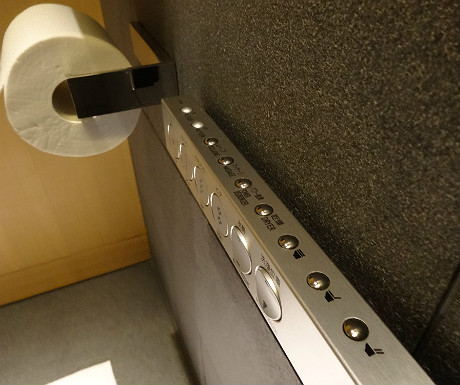 I was there as part of my trip with ANA (All Nippon Airways), having flown from the UK to Tokyo Haneda International Airport en route to Singapore. It was an opportunity not only to try out ANA’s business class seating but also to spend a few days in the Japanese capital. It was a chance to test the airline’s commitment to quality and service as demonstrated by its By Design campaign and to seek those same values in Japanese culture and traditions.
Returning to the toilets… its not just the lavatories that leave me a little perplexed. Wandering around Tokyo could leave you thinking you are in one huge operating theatre – many citizens wear face masks and yet Tokyo is one of the least polluted cities in the country, with very little industry. Apparently, these masks are worn more for the prevention of spreading or catching germs, and for some other reasons, rather than pollution concerns. The fascination with anime and manga by grown adults, not just children – is something that’s also completely alien to me.
I was there as part of my trip with ANA (All Nippon Airways), having flown from the UK to Tokyo Haneda International Airport en route to Singapore. It was an opportunity not only to try out ANA’s business class seating but also to spend a few days in the Japanese capital. It was a chance to test the airline’s commitment to quality and service as demonstrated by its By Design campaign and to seek those same values in Japanese culture and traditions.
Returning to the toilets… its not just the lavatories that leave me a little perplexed. Wandering around Tokyo could leave you thinking you are in one huge operating theatre – many citizens wear face masks and yet Tokyo is one of the least polluted cities in the country, with very little industry. Apparently, these masks are worn more for the prevention of spreading or catching germs, and for some other reasons, rather than pollution concerns. The fascination with anime and manga by grown adults, not just children – is something that’s also completely alien to me.
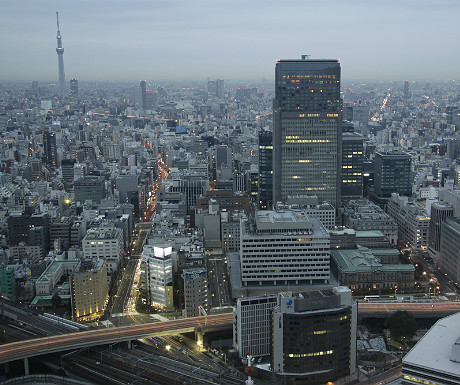 With all this unfamiliarity, I was glad to have the services of two guides during my stay in the city. This proved to be invaluable and something Id recommend to any first-time visitor to Tokyo, even if its just to help you get around. There are more than 500 stations within Tokyos remarkable transport network and it was comparatively recently that these were marked in English. I cant imagine how difficult it must have been for a non-native to navigate before this.
To help me through this minefield, I first enlist the help of Context Travel – who go by the slogan ‘tours for the culturally curious’ – and am accompanied by Darren, an informative Australian who has been living in Japan for the past year. We first head for Asakusa, Tokyos old downtown. As we emerge from the metro system, Tokyos Skytree (left) stands tall alongside the Kirin beer company (centre), built to look like a glass of beer with froth on the top. Alongside it is a sculpture dubbed the ‘golden turd’ (right) – perhaps not one of Philippe Stark’s finest moments since it’s supposed to represent foam rising from a beer mug.
With all this unfamiliarity, I was glad to have the services of two guides during my stay in the city. This proved to be invaluable and something Id recommend to any first-time visitor to Tokyo, even if its just to help you get around. There are more than 500 stations within Tokyos remarkable transport network and it was comparatively recently that these were marked in English. I cant imagine how difficult it must have been for a non-native to navigate before this.
To help me through this minefield, I first enlist the help of Context Travel – who go by the slogan ‘tours for the culturally curious’ – and am accompanied by Darren, an informative Australian who has been living in Japan for the past year. We first head for Asakusa, Tokyos old downtown. As we emerge from the metro system, Tokyos Skytree (left) stands tall alongside the Kirin beer company (centre), built to look like a glass of beer with froth on the top. Alongside it is a sculpture dubbed the ‘golden turd’ (right) – perhaps not one of Philippe Stark’s finest moments since it’s supposed to represent foam rising from a beer mug.
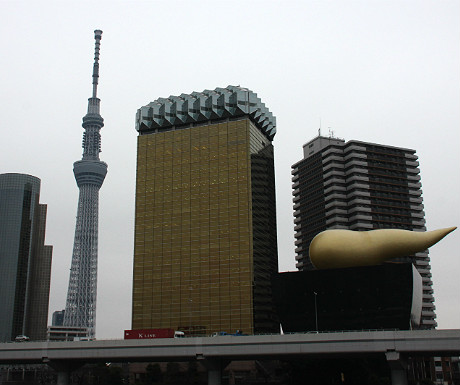 We venture towards Sensō-ji, an ancient Buddhist temple with an adjacent Shinto shrine. The site has a history dating back to the 7th Century but the temple was bombed during World War II and has since been re-built.
We venture towards Sensō-ji, an ancient Buddhist temple with an adjacent Shinto shrine. The site has a history dating back to the 7th Century but the temple was bombed during World War II and has since been re-built.
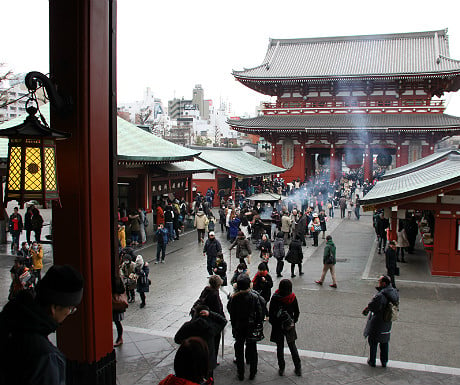 As we reach the temple, we stop at an omikuji stall and Darren shakes a metal container in my direction, telling me to select a fotune stick. It has the number 92 on it and we find the corresponding drawer to find my fortune.
As we reach the temple, we stop at an omikuji stall and Darren shakes a metal container in my direction, telling me to select a fotune stick. It has the number 92 on it and we find the corresponding drawer to find my fortune.
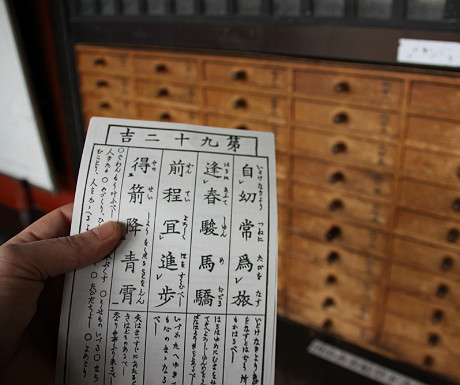 I’m in luck… it’s a good fortune! What’s more, this is one of the few shrines where the fortune is also written in English. The translation on the reverse reads:
No. 92 GOOD FORTUNE. Always traveling around since your childhod has given you a lot of places. It is a good sign to dream of a young horse in spring and a dream of a swift horse will bee a much better sign. Wherever you go, everything can be done as you wish. When an arrow goes straight, you will get a catch. Good luck will come to you from the heaven. *Your wish will come true. *The sick person will get well. *The lost article will be found. *The person you are waiting for will come soon. *Building a new house and removal are both good. *It is good to make a travel. *Marriage and employment are both good.
Darren is less fortunate and selects a bad fortune so ties it to something, as is the tradition, in order to leave the bad luck behind. This is a popular attraction in Tokyo, particularly at the time of Sanja Matsuri, a Shinto festival to honour the three founders of Sensō-ji when an estimated two million people visit in a period of just three days.
I’m in luck… it’s a good fortune! What’s more, this is one of the few shrines where the fortune is also written in English. The translation on the reverse reads:
No. 92 GOOD FORTUNE. Always traveling around since your childhod has given you a lot of places. It is a good sign to dream of a young horse in spring and a dream of a swift horse will bee a much better sign. Wherever you go, everything can be done as you wish. When an arrow goes straight, you will get a catch. Good luck will come to you from the heaven. *Your wish will come true. *The sick person will get well. *The lost article will be found. *The person you are waiting for will come soon. *Building a new house and removal are both good. *It is good to make a travel. *Marriage and employment are both good.
Darren is less fortunate and selects a bad fortune so ties it to something, as is the tradition, in order to leave the bad luck behind. This is a popular attraction in Tokyo, particularly at the time of Sanja Matsuri, a Shinto festival to honour the three founders of Sensō-ji when an estimated two million people visit in a period of just three days.
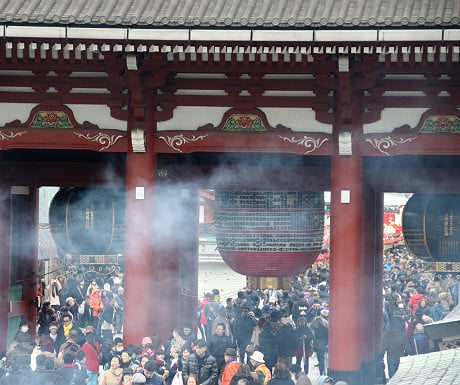 Our next stop is a ramen shop. The ordering system intrigues me. There are models of the dishes outside, and a machine where you select what youd like and it spews out a ticket.
Our next stop is a ramen shop. The ordering system intrigues me. There are models of the dishes outside, and a machine where you select what youd like and it spews out a ticket.
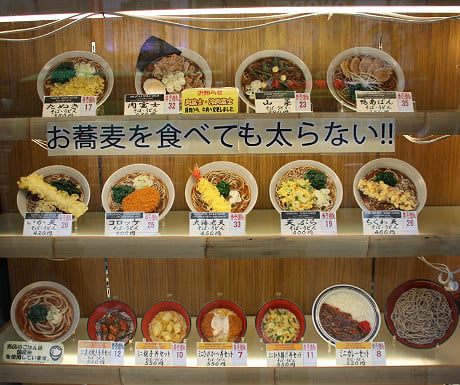
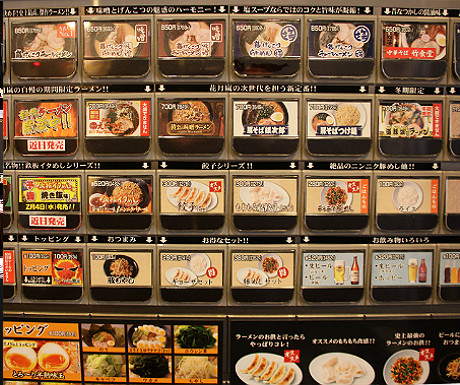 I learn from Darren that, when it comes to food, the Japanese talk about five basic tastes not just sweet, sour, bitter and salty – but also umami which apparently translates to mean ‘delicious and savoury’ yet is distinct from salty and said to be found in foods with a high level of glutamate. The term is a new one to me and, as we try the gyoza, I’m not sure if I can put my finger – or rather, my tastebuds – on it, but they’re good nevertheless.
I learn from Darren that, when it comes to food, the Japanese talk about five basic tastes not just sweet, sour, bitter and salty – but also umami which apparently translates to mean ‘delicious and savoury’ yet is distinct from salty and said to be found in foods with a high level of glutamate. The term is a new one to me and, as we try the gyoza, I’m not sure if I can put my finger – or rather, my tastebuds – on it, but they’re good nevertheless.
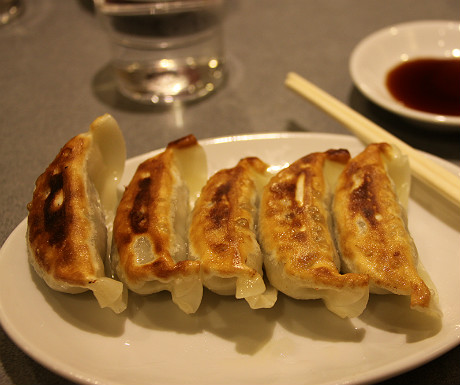 Following our snack, we move on to Ueno Park where they celebrate Hanami – an amazing cherry blossom spectacle for just two weeks in April. There are over one thousands trees along the street leading towards the National Museum and around Shinobazu Pond. They are decidedly bare at the time of our visit, but this will soon change and the area will be packed with Hanami picnic parties. Visitors will claim their ‘spot’ on a ‘first come, first served’ basis by laying down a picnic sheet, but without claiming an area that is larger than they need. One thing I learnt on my visit is that the Japanese are a polite and respectful nation.
Following our snack, we move on to Ueno Park where they celebrate Hanami – an amazing cherry blossom spectacle for just two weeks in April. There are over one thousands trees along the street leading towards the National Museum and around Shinobazu Pond. They are decidedly bare at the time of our visit, but this will soon change and the area will be packed with Hanami picnic parties. Visitors will claim their ‘spot’ on a ‘first come, first served’ basis by laying down a picnic sheet, but without claiming an area that is larger than they need. One thing I learnt on my visit is that the Japanese are a polite and respectful nation.
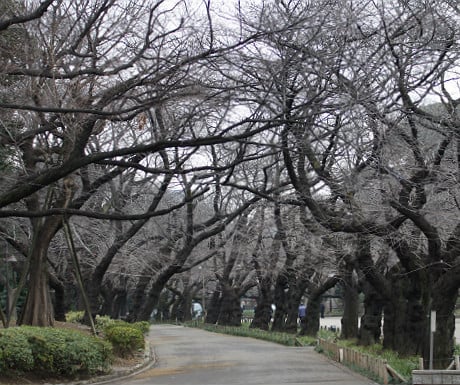 After passing through a bustling market that lies beneath some train tracks, we move on to Akihabara, known as the Electric City because it’s a part of Tokyo where you’ll find everything (and anything!) electrical.
After passing through a bustling market that lies beneath some train tracks, we move on to Akihabara, known as the Electric City because it’s a part of Tokyo where you’ll find everything (and anything!) electrical.
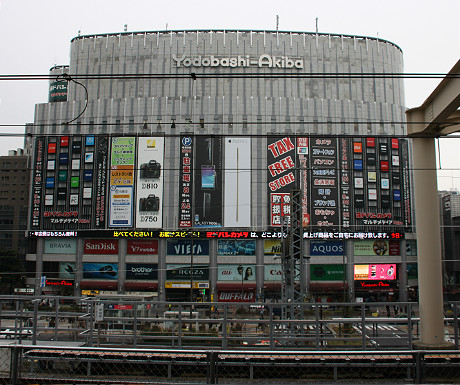 Whether you’re after solenoids or speakers, you’ll find it all here.
Whether you’re after solenoids or speakers, you’ll find it all here.
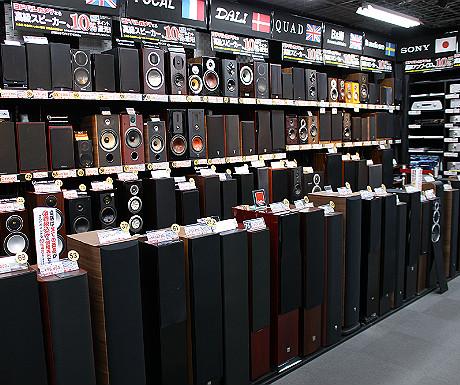 Darren points out some bizarre-looking contraptions for strengthening facial muscles and, I think, for keeping your skin young and supple. Theres not just one or two on the market theres scores of them and theyre not cheap either.
Darren points out some bizarre-looking contraptions for strengthening facial muscles and, I think, for keeping your skin young and supple. Theres not just one or two on the market theres scores of them and theyre not cheap either.
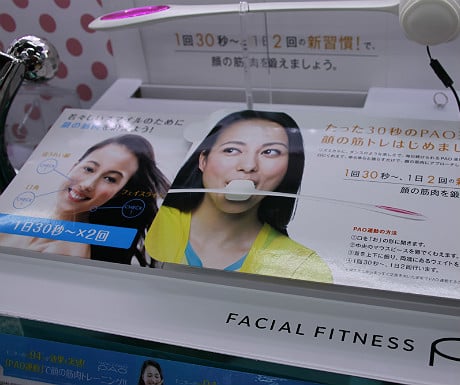 Here we also find ourselves in the manga and anime district, where women dressed in maid costumes beckon passers-by to dine in maid cafés. Apparently, it’s all very innocent. If I was able to relate to manga or anime in any way, perhaps it would all make more sense to me but instead I’m left feeling rather culturally ignorant, but happy to be that way!
Here we also find ourselves in the manga and anime district, where women dressed in maid costumes beckon passers-by to dine in maid cafés. Apparently, it’s all very innocent. If I was able to relate to manga or anime in any way, perhaps it would all make more sense to me but instead I’m left feeling rather culturally ignorant, but happy to be that way!
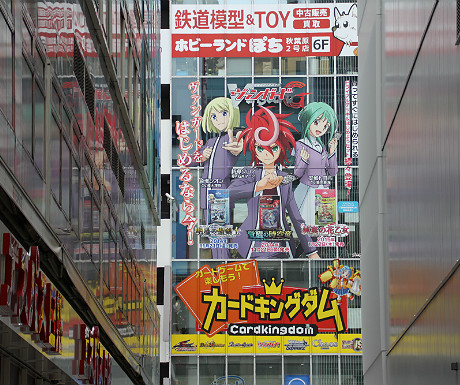 The following day, I value the company of another guide Yuki, organised through Inside Japan – and see another side to the city, starting at Tsukiji fish market.
The following day, I value the company of another guide Yuki, organised through Inside Japan – and see another side to the city, starting at Tsukiji fish market.
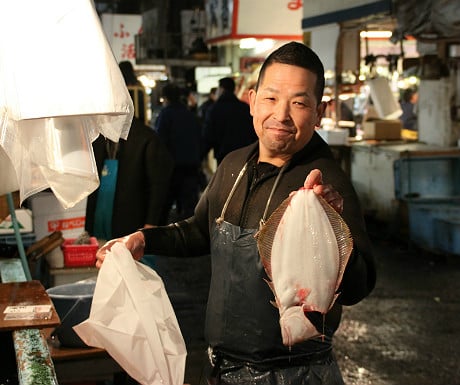 You need to have your wits about you when you first arrive as there are little vehicles whizzing about from one place to another. Tsukiji itself I find fascinating – it is the largest fish market in the world. I could watch for hours as traders scurry up and down, fish are gutted, knives are sharpened and a huge block of frozen tuna is cut into steaks with the aid of a bandsaw.
You need to have your wits about you when you first arrive as there are little vehicles whizzing about from one place to another. Tsukiji itself I find fascinating – it is the largest fish market in the world. I could watch for hours as traders scurry up and down, fish are gutted, knives are sharpened and a huge block of frozen tuna is cut into steaks with the aid of a bandsaw.
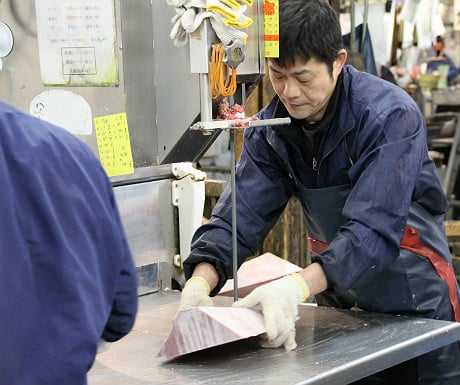
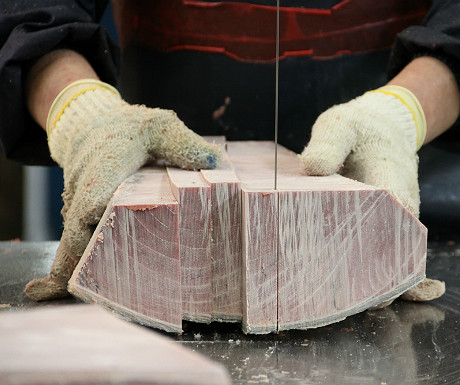 I feel honoured to experience the market since it is due be re-located to Tokyo’s Toyosu district next year and ask my guide if I can browse a little longer, and she duly obliges. This place should be high on your ‘to do’ list if visiting Tokyo and you have until November 2016 before it moves ahead of the 2020 Olympics.
I feel honoured to experience the market since it is due be re-located to Tokyo’s Toyosu district next year and ask my guide if I can browse a little longer, and she duly obliges. This place should be high on your ‘to do’ list if visiting Tokyo and you have until November 2016 before it moves ahead of the 2020 Olympics.
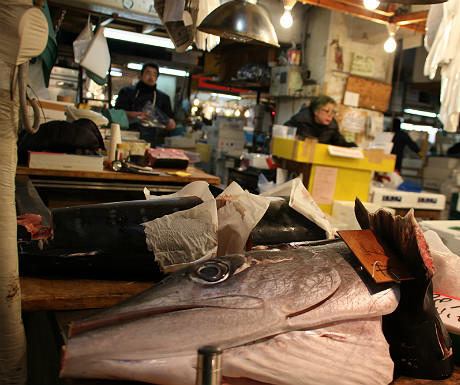
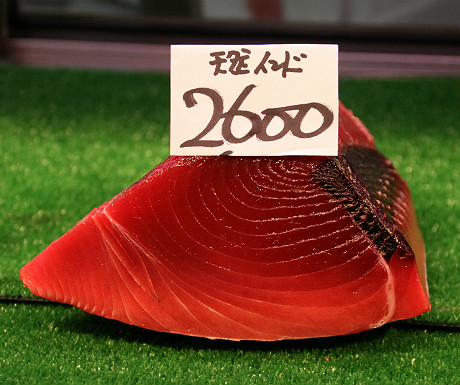 Five million pounds of seafood worth in the region of $30 million is handled here every day, involving an estimated 60,000-strong workforce.
Five million pounds of seafood worth in the region of $30 million is handled here every day, involving an estimated 60,000-strong workforce.
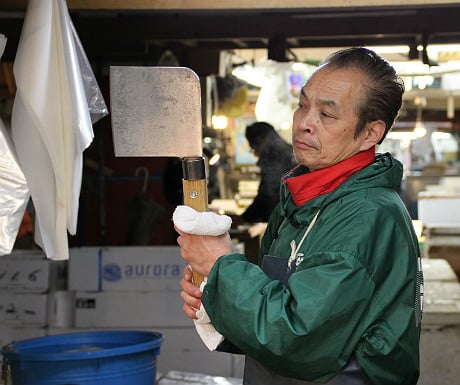
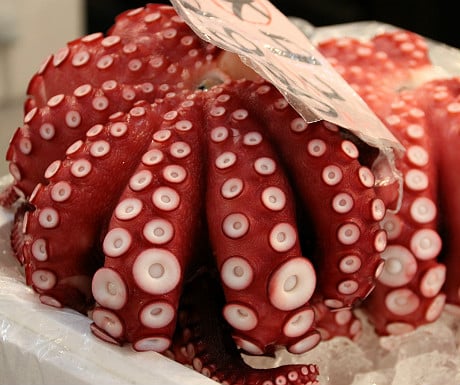 There are seven main wholesalers licensed by the government at the fish market, 800 intermediate wholesalers and some 300 or so retailers just outside the market but with some association with the industry vendors of dried fish, bonite flakes, kelp, pickles, tsukudani, knives and more, as well as a number of eateries.
There are seven main wholesalers licensed by the government at the fish market, 800 intermediate wholesalers and some 300 or so retailers just outside the market but with some association with the industry vendors of dried fish, bonite flakes, kelp, pickles, tsukudani, knives and more, as well as a number of eateries.
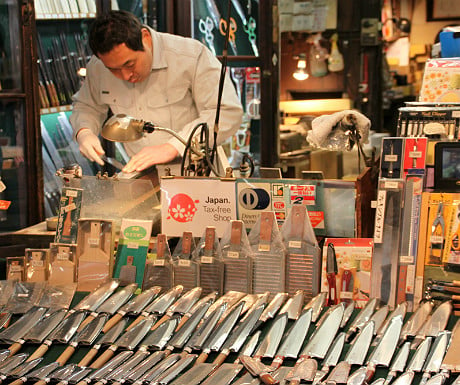
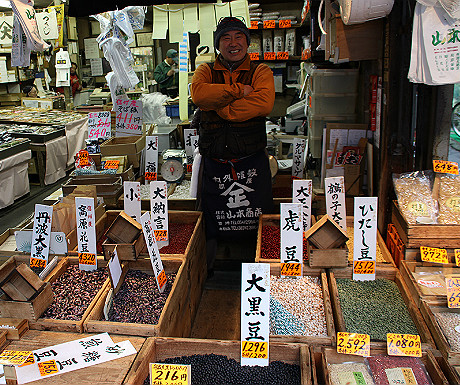
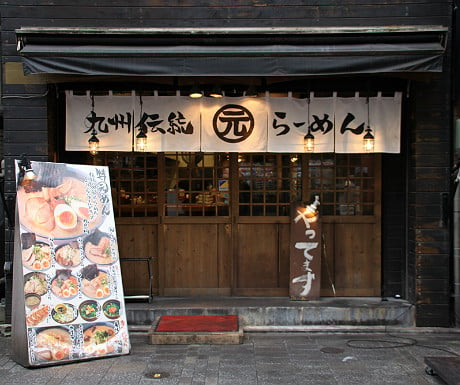 With our browsing complete, we take shelter from the rain at the Sushi Zanmai sushi restaurant. Staff here have name badges that show which of the 47 prefectures of Japan they are from, and what their hobby is. Our sushi chef, who apparently likes sport, prepares me the traditional sushi platter, an assortment of sushi which includes raw tuna, cooked conger eel, salmon roe, squid and kelp with herring roe.
With our browsing complete, we take shelter from the rain at the Sushi Zanmai sushi restaurant. Staff here have name badges that show which of the 47 prefectures of Japan they are from, and what their hobby is. Our sushi chef, who apparently likes sport, prepares me the traditional sushi platter, an assortment of sushi which includes raw tuna, cooked conger eel, salmon roe, squid and kelp with herring roe.
 With our fill of sushi, we move on to Hama-rikyu Gardens, the family garden of the Tokugawa Shogun which served as an outer fort for Edo Castle and that retains a tidal pond of seawater. Black pine trees appear to do well here, against a backdrop of high-rise buildings, and Yuki tells me they are regarded as a symbol of eternity.
With our fill of sushi, we move on to Hama-rikyu Gardens, the family garden of the Tokugawa Shogun which served as an outer fort for Edo Castle and that retains a tidal pond of seawater. Black pine trees appear to do well here, against a backdrop of high-rise buildings, and Yuki tells me they are regarded as a symbol of eternity.
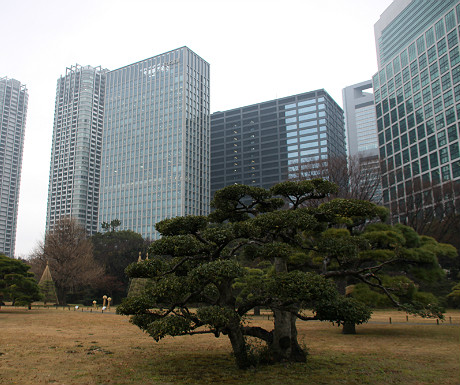 Plum trees also thrive and these are considered lucky because they are the first to blossom (in January). Interestingly, there are also two kamboba (or duck hunting sites) here, dating back to the late 18th Century.
We also visit Meiji Jingu, a Shinto shrine dedicated to the divine souls of Emperor Meiji, the 122nd Emperor of Japan and great-grandfather of the current Emperor, before moving on to the area of Omotesando Hills where we come across a thriving shopping area, and an art gallery exhibiting emerging artists. We pass a shop that is apparently a favourite of Lady Gaga’s whenever she is in the city, and it’s clear to see why. The shop attendant is dressed in an orange baseball cap and… well, I’m not really sure how to continue with my description, so the picture will just have to do!
Plum trees also thrive and these are considered lucky because they are the first to blossom (in January). Interestingly, there are also two kamboba (or duck hunting sites) here, dating back to the late 18th Century.
We also visit Meiji Jingu, a Shinto shrine dedicated to the divine souls of Emperor Meiji, the 122nd Emperor of Japan and great-grandfather of the current Emperor, before moving on to the area of Omotesando Hills where we come across a thriving shopping area, and an art gallery exhibiting emerging artists. We pass a shop that is apparently a favourite of Lady Gaga’s whenever she is in the city, and it’s clear to see why. The shop attendant is dressed in an orange baseball cap and… well, I’m not really sure how to continue with my description, so the picture will just have to do!
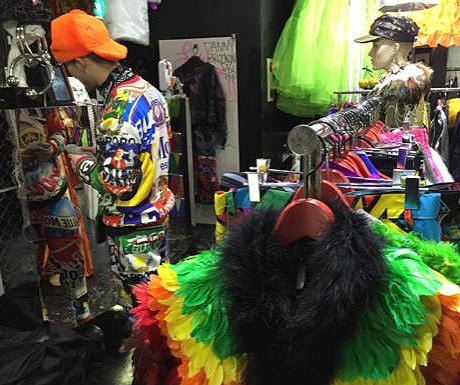 Then it’s on to Kagurazaka, a neighbourhood of the city famous for its shopping, cafés and restaurants. The 2015 Michelin Guide to Tokyo has no less than 12 three-star restaurants, 53 two-star restaurants, 161 one-star restaurants and 325 Bib Gourmands, making it the unofficial gastronomic capital of the world, ahead of even Paris. A number of them can be found here, yet you often wouldn’t know it as they are housed in buildings that give little away.
My first time in Tokyo was all too brief but I was fortunate enough to have seen a great deal, and I can’t understimate the importance of hiring a guide if you are not already familiar with the city and how to get around. For me, it was invaluable given the short time I had.
When it came to leaving the city for Singapore, there were two things that I’d wanted to do but hadn’t been able. One was to see Mount Fuji which I’m told is visible from Tokyo for only 80 days of the year, but I was lucky enough to catch a glimpse from the air on my departure. The other was to see some Sumo wrestling; I’d been unable to do that because the tickets were all sold out (apparently there are some young Sumo wrestlers that are very popular at the moment); that was slightly disappointing but, on the plus side, it gives me a good excuse to make a return visit some time.
Disclosure: This post was created in partnership with ANA – All Nippon Airways. All opinions expressed in the post are my own and not those of ANA.
Then it’s on to Kagurazaka, a neighbourhood of the city famous for its shopping, cafés and restaurants. The 2015 Michelin Guide to Tokyo has no less than 12 three-star restaurants, 53 two-star restaurants, 161 one-star restaurants and 325 Bib Gourmands, making it the unofficial gastronomic capital of the world, ahead of even Paris. A number of them can be found here, yet you often wouldn’t know it as they are housed in buildings that give little away.
My first time in Tokyo was all too brief but I was fortunate enough to have seen a great deal, and I can’t understimate the importance of hiring a guide if you are not already familiar with the city and how to get around. For me, it was invaluable given the short time I had.
When it came to leaving the city for Singapore, there were two things that I’d wanted to do but hadn’t been able. One was to see Mount Fuji which I’m told is visible from Tokyo for only 80 days of the year, but I was lucky enough to catch a glimpse from the air on my departure. The other was to see some Sumo wrestling; I’d been unable to do that because the tickets were all sold out (apparently there are some young Sumo wrestlers that are very popular at the moment); that was slightly disappointing but, on the plus side, it gives me a good excuse to make a return visit some time.
Disclosure: This post was created in partnership with ANA – All Nippon Airways. All opinions expressed in the post are my own and not those of ANA.Did you enjoy this article?
Receive similar content direct to your inbox.


Paul, so glad you enjoyed your time with Darren! It was our pleasure to have you on a tour. Hope to see you again soon. Best, Sophie – Context Travel
Thank you, Sophie… Darren was a pleasure to be with, knowledgeable, very patient with my questions, and a credit to Context Travel.
This is the way that we also discovered Tokyo, with a volunteer tour guide. I think that the insider information that we were able to gain from him made our trip and our subsequent trips to Tokyo that much easier. We now know about food, culture, and also discovered that Tokyo is not nearly as expensive as people think, if you do it the local way. Re the toilets – they kept me amused for ages as I played with the buttons, hitting bird calls and hitting buttons that maybe I should;t have. Pleased you enjoyed Tokyo.
Thanks, Paula… yes, I would certainly be much more confident ‘going it alone’ on a second visit, I think… thanks also for your comments and suggestions on the other post prior to the trip. Everyone has been so helpful. :-)
I think that having a guide is somewhere so different to home is such a good idea, you clearly saw a great deal in a short time but also got more understanding to! As for the toilets… not sure we are ready for them over here, although lids that go down automatically is a useful idea…
There’s so much about Japan that seems culturally alien, or perhaps it’s just that the language is a barrier when we are so used to everyone speaking English. I think I would also use a guide to get my bearings if I visit.
We didn’t expect to love Tokyo as much as we did. But it turned out to be one of our favourite cities. We only spent a few days there but are desperate to go back. And your amazing photos made us want to go back even more!
Tsukiji Fish Market was a real experience!
We will be in Tokyo in around 9th June for 3 days and would like a tour guide…Darren.
There will be 4 agile adults in our 70s.
I’d like to go back to Tokyo and bring with me my kids. It’s such a lovely city and I had a great experience with the people I met.
Cant wait to explore this city in my honeymoon. Counting the days till then.
:)
hello from Romania
How do you avail of the free services of the Tour Guide? Where do you meet them? Do you feed them? Thanks.
The tour guides are not free. The two I used were from Context Travel ( https://www.contexttravel.com/ ) and Inside Japan ( https://www.insidejapantours.com/ ), and I’d recommend them both.
I am visiting Tokyo over NYE this year and will most definitely look into hiring a guide for part of my travels. Thank you for sharing a very useful post :)
Hi Lauren – if it is your first time in Tokyo, I’m sure you will not be disappointed with either of the two who guided me. Their first-hand experiences were invaluable to me. Just guiding me around the transport system – let alone all the other gems that I gleamed from them – was itself invaluable.
Great post Paul. It makes me want to visit Japan all the more which I hope to do in May and loved your pictures (I am also a keen photographer). I am a solo traveller and have visited China independently and loved the experience (and the language barrier challenges though I did learn some Mandarin beforehand!). I also want to go it alone to Japan visiting not only Tokyo but also Kyoto and Hiroshima. Have you been to the latter two? Is the transport system in Tokyo easy to navigate without a guide?
Hi Jackie – sadly I only had a few nights before heading on to Singapore so didn’t have time to see beyond Tokyo. I’m sure the transport system would be easy enough to navigate without a guide once you got to grips with the basics, but for my short visit – and wishing to maximise the time I had available – I was thankful for the help. :)
Jackie, the metro system in Tokyo is superb and easy to navigate. It looks confusing but as long as you have a map,you’ll be fine. Google is pretty good at giving you the best routes between stations too. When you arrive,buy a Suica card from a machine at a station, top it up and you can travel easily throughtout the whole system without having to buy tickets every time!
The Shinkansen is a great way to get from Tokyo to Kyoto and is worth the expense for the experience alone. We got an overnight coach from Kyoto to Hiroshima but am sure that there will be trains too.
All in all, we found Japan easy to independently travel in. If you do have any problems,people are more than happy to help and many will go out of their way to make sure you get where you are trying to go!
Hi Jackie,
My husband and I visited Japan in 2014. We bought a Japan rail pass which you need to buy before you go but well worth the money. The App Hyperdia was very useful for times of train etc. We travelled from Tokyo to Hiroshima, over to Myajamia island (where we got engaged) then on to Kobe, Kyoto and Mount Fuji all before heading back to Tokyo and we did this in 14 days. In Kobe we had the best steak ever – Waggu, in Myajima we stayed in a Ryokan and in Kyoto we went to a Maiko evening. Loved, loved, loved Japan!!!!
I love those Japanese toilets. They are a true marvel of technology. It makes me feel like I live in a third world country. Why aren’t heated toilet seats standard?
I’ve always been a fan of most Japanese things. I love their anime most esspecially the food. Everything is so fresh and healthy. Tea as well. But I do find that they have a lot of quirky things as well, like those capsule hotels (that has improved a lot, I must say) and the high-tech toilets. I couldn’t even figure out what to press as many come in Japanese. But I guess those are what makes the experience of Japan unique.
With the alliteration of this title and sheer left-field thinking this post was always going to attract shedloads of readers. For me this piece epitomises what good travel-writing is all about, you paint a picture of a far distant land and very remote from my lifestyle.
I get the sense of a culture that is very different to the one I live in and I always find that very intriguing.
I am fairly certain that I could cope with the culture shock of the toilet but some of the other stuff might take some adjustments.